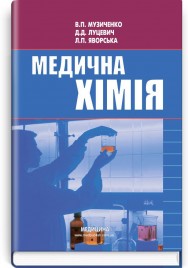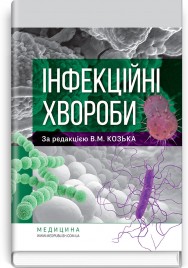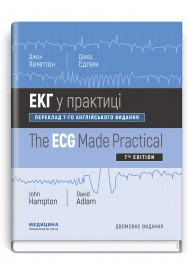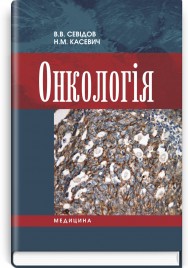Описание книги Biological and Bioorganic Chemistry: in 2 books. Book 2. Biological Chemistry: textbook / Yu.I. Gubsky, I.V. Nizhenkovska, М.М. Korda et al. — 2nd edition
This textbook contains a systematic presentation of the course of biological chemistry according to the educational program for students of higher medical (pharmaceutical) educational establishments. The core text of this book examines the structure of an enzyme, and the metabolic pathways of the major classes of biomolecules (proteins, amino acids, carbohydrates, lipids, nucleotides, porphyrins); structural features and properties of nucleic acids, DNA and RNA; molecular biology and genetics, biochemical foundations of the physiological functions of the human body and their neurohumoral regulation are highlighted. Considerable attention is paid to the molecular mechanisms underlying the functions of blood cells, liver, kidneys, muscles, connective tissue, immune and nervous systems. The biochemical basis of the pathogenesis of atherosclerosis, diabetes mellitus, obesity, diseases of the endocrine, immune, nervous systems and connective tissue are considered. In addition to informational material, each chapter of the textbook contains tests and tasks for self-control.
Содержание книги Biological and Bioorganic Chemistry: in 2 books. Book 2. Biological Chemistry: textbook / Yu.I. Gubsky, I.V. Nizhenkovska, М.М. Korda et al. — 2nd edition
Introduction. History of development of biochemistry
PART I. GENERAL PRINCIPLES OF REGULATION OF METABOLISM
Chapter 1. Biomolecules and cellular structures
1.1. Chemical composition of living organism
1.2. Biomolecules and their functions
1.3. Scheme of structure of prokaryotic and eukaryotic cells
1.4. Biological membranes
Chapter 2. Enzymes
2.1. Enzymes: structure, properties and classification
2.2. Mechanism of the enzyme action
2.3. Kinetics of enzymatic reactions. The units of enzymatic activity
2.4. Regulation of enzymatic processes
2.5. Medical enzymology
2.6. Cofactors and coenzymes: chemical structure and functions
Chapter 3. Fundamental regularities of metabolism. Tricarboxylic acid cycle
3.1. Common pathways of protein, lipid, and carbohydrate metabolism
3.2. Oxidative decarboxylation of pyruvic acid
3.3. Tricarboxylic acid cycle or Krebs cycle
Chapter 4. Molecular foundations of bioenergetics
4.1. Pathways of the oxygen consumption in the reactions of biological oxidation
4.2. Tissue respiration
4.3. Chemiosmotic mechanism of ATP synthesis in mitochondria
4.4. Non-phosphorylative oxidation in electron trasport chain as the mechanism of heat production in the mitochondria
4.5. Inhibitors and uncouplers of oxidative phosphorylation
Chapter 5. Hormonal regulation of metabolism
5.1. General characteristics of hormones
5.2. Classification of hormones
5.3. Mechanism of action of hydrophilic hormones
5.4. Mechanism of action of hormones that interact with the intracellular receptors
5.5. Regulation of secretion of hormones
PART II. CARBOHYDRATE, LIPID AND AMINO ACID METABOLISM. REGULATION OF CARBOHYDRATE, LIPID AND AMINO ACID METABOLISM
Chapter 6. Carbohydrate metabolism. Regulation of carbohydrate metabolism
6.1. Glycolysis
6.2. Alcohol fermentation
6.3. Pentose phosphate pathway of glucose metabolism
6.4. Metabolism of fructose
6.5. Metabolism of sorbitol
6.6. Metabolism of galactose
6.7. Gluconeogenesis
6.8. Metabolism of glycogen
6.9. Regulation of glycogenolysis and glycogenesis
Chapter 7. Lipid metabolism. Regulation of lipid metabolism
7.1. Metabolism of triacylglycerols
7.2. Metabolism of fatty acids
7.3. Metabolism of glycerol
7.4. Ketone body formation and utilization in normal and pathological conditions
7.5. Metabolism of phospholipids
7.6. Metabolism of cholesterol
7.7. Disorders of lipid metabolism
Chapter 8. Amino acid metabolism. Enzymopathies of amino acid metabolism
8.1. General pathways of amino acids transformation
8.2. Formation and detoxification of ammonia. Urea cycle
8.3. Specialized pathways of acyclic and cyclic amino acids
8.4. Biosynthesis of porphyrins
8.5. Hereditary disorder of porphyrin metabolism
PART III. MOLECULAR BIOLOGY. BIOCHEMISTRY OF INTERCELLULAR COMMUNICATIONS
Chapter 9. Metabolism of nucleotides
9.1. Biosynthesis and catabolism of purine and pyrimidine nucleotides
9.2. Disorders of purine and pyrimidine metabolism
Chapter 10. Fundamentals of molecular biology
10.1. Structure of deoxyribonucleic acid
10.2. Biosynthesis of deoxyribonucleic acid
10.3. Biosynthesis of ribonucleic acid (RNA)
10.4. Ribosomal protein syntesis (translation)
10.5. Antibiotics are inhibitors of template synthesis
10.6. Viruses and toxins are inhibitors of template synthesis in eukaryotic cells
10.7. Biochemical mechanism of antiviral effect of interferons
Chapter 11. Fundamentals of molecular genetics
11.1. Phases of eukaryotic cell cycle. Biochemical mechanism of control of cell entry into mitosis
11.2. Molecular mechanism of mutations
11.3. Genetic recombinations
11.4. Amplification of genes (genes of metallothionein, dihydrofolate reductase)
11.5. Genetic engineering: some basic concepts, biomedical significance
Chapter 12. Biochemistry of hormonal regulation
12.1. Hormones of hypotalamic-pituitary system
12.2. Pancreatic hormones
12.3. Hormones of digestive system
12.4. Hormones of thyroid gland
12.5. Hormonal regulation of calcium homeostasis
12.6. Steroid hormones of adrenal glands and gonads
12.7. Biological active eicosanoids
12.8. Eicosanoids in the inflammation
Part IV. FUNCTIONAL BIOCHEMISTRY
Chapter 13. Biochemystry of human nutrition
13.1. Macronutrients
13.2. Biochemical role of microelements
13.3. Digestion of nutrients in the digestive tract
13.4. Violations of digestion in alimentary canal
13.5. Vitamins
Chapter 14. Biochemistry of blood
14.1. Respiratory function of red blood cells
14.2. Normal and pathological forms of hemoglobin
14.3. Acid-base balance and buffer systems of blood
14.4. Non-protein components of plasma
14.5. Blood proteins
14.6. Blood plasma lipoproteins
14.7. Blood coagulation, anticoagulant and fibrinolytic systems
Chapter 15. Biochemistry of immune processes
15.1. Immunoglobulins: structure, biological functions
15.2. Mediators and hormones of immune system
15.3. Biochemical components of human complement system
15.4. Biochemical mechanisms of development of immunodeficiency
Chapter 16. Biochemical functions of the liver
16.1. Bile formation in liver
16.2. Metabolism of bile pigments in the liver
16.3. Pathobiochemistry ofjaundice
16.4. Biochemical disturbances in certain liver diseases
16.5. Biotransformation of xenobiotics and endogenous toxins
Chapter 17. Biochemical functions of the kidneys
17.1. Steps of urine formation
17.2. Physical characteristics of urine
17.3. Chemical composition of urine
17.4. Role of the kidneys in acid-base balance
17.5. Features of kidney metabolism
17.6. Biochemical tests of kidney function
Chapter 18. Biochemistry of muscles
18.1. Structure of myofibrils
18.2. Chemical composition of muscle tissue
18.3. Biochemical features of cardiac and smooth muscles
18.4. Biochemical mechanisms of contraction and relaxation of muscles
18.5. Sources of energy for muscle constractions
18.6. Biochemical changes in muscle pathology
Chapter 19. Biochemistry of connective tissue
19.1. Structure and metabolism of collagen
19.2. Elastin structure
19.3. Structure and metabolism of proteoglycans
19.4. Structure of glycoproteins
Chapter 20. Biochemistry of nervous system
20.1. Chemical composition of the nervous system
20.2. Nervous tissue metabolism
20.3. Molecular basis of bioelectrical processes on the membrane of neurons
20.4. Neurotransmitters
20.5. Metabolism of neurotransmitters and neuromodulators in mental disorders
20.6. Neurochemical mechanisms of psychotropic drugs
Answers for tests for self-control
Index
References
Авторы книги Biological and Bioorganic Chemistry: in 2 books. Book 2. Biological Chemistry: textbook / Yu.I. Gubsky, I.V. Nizhenkovska, М.М. Korda et al. — 2nd edition
Yu.I. Gubsky, I.V. Nizhenkovska, М.М. Korda, B.G. Borzenko, O.Z. Brazaluk, G.M. Ersteniuk, K.O. Efetov, V.I. Zhukov, N.V. Zaichko, I.O. Komarevtseva, M.B. Lutsyuk, O.O. Mardashko, I.F. Meshchyshen, K.S. Neporada, O.Ya. Sklyarov, L.M. Tarasenko, O.M. Torokhtin, T.I. Bondarchuk, O.V. Kuznetsova, O.V. Lozova, A.S. Yagupova
Характеристики книги Biological and Bioorganic Chemistry: in 2 books. Book 2. Biological Chemistry: textbook / Yu.I. Gubsky, I.V. Nizhenkovska, М.М. Korda et al. — 2nd edition
Издательство: Всеукраинское специализированное издательство «Медицина»
Форма: печатная книга (издание)
Вид: учебник
Язык: английский
Год и номер издания: 2021, 2-е (стереотипное)
Количество страниц: 544 (черно-белые)
Обложка: твердая
Формат: 70х100/16
Вес: 872 г
ISBN: 978-617-505-886-2 (9786175058862)



 Архив содержит книги, которых нет в наличии, но которые в ближайшее время, возможно, будут переизданы.
Архив содержит книги, которых нет в наличии, но которые в ближайшее время, возможно, будут переизданы.
 01054, г. Киев, ул.
01054, г. Киев, ул.






















